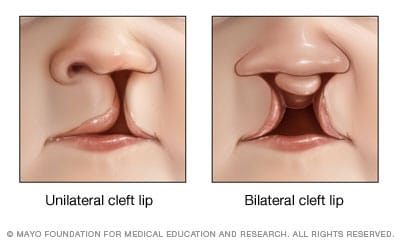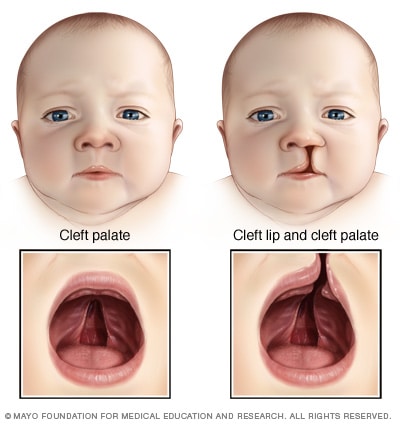Overview
Cleft lip

Cleft lip
A cleft lip is an opening or split in the upper lip that doesn't close fully when an unborn baby is developing in the womb. Cleft lip may happen only on one side (unilateral) or both sides (bilateral). A baby with a cleft lip also may have a cleft in the roof of the mouth called a cleft palate.
Cleft palate

Cleft palate
A cleft palate is an opening or split in the roof of the mouth that occurs when the tissue doesn't close fully during development in the womb before birth. A cleft palate often includes a split in the upper lip (cleft lip), but it can occur without affecting the lip.
Cleft lip and cleft palate are openings or splits in the upper lip, the roof of the mouth (palate) or both. Cleft lip and cleft palate occur when an unborn baby's face and mouth are developing and the upper lip and palate don't close fully.
Cleft lip and cleft palate are among the most common birth defects. These birth defects can occur on their own or together. Sometimes a syndrome may cause these birth defects. But the cause is often not known.
Having a baby born with a cleft can be upsetting, but treatment can correct cleft lip and cleft palate. After a series of surgeries, the lips and palate work like they should and the baby looks much better. Usually, only slight scarring occurs.
Products & Services
Symptoms
Usually, a split (cleft) in the lip or roof of the mouth (palate) can be seen right away at birth. It may be found before birth during a prenatal ultrasound. Cleft lip and cleft palate may look like:
- A split in the lip and palate that affects one or both sides of the face.
- A split in the lip that appears as only a small notch in the lip or extends from the lip through the upper gum and palate into the bottom of the nose.
- A split in the roof of the mouth that doesn't affect how the face looks.
Less often, a cleft occurs only in the muscles of the soft palate, which are at the back of the mouth and covered by the mouth's lining. This is called a submucous cleft palate. This type of cleft may not be seen at birth and may not be diagnosed until later when signs arise, such as:
- Having a hard time feeding.
- Nasal speaking voice.
- Constant ear infections.
- Rarely, having a hard time swallowing. Liquids or foods may come out of the nose.
When to see a doctor
A cleft lip and cleft palate may be seen at birth or may be found on ultrasound before birth. Your healthcare professional can start coordinating care at that time. If your baby has symptoms of a submucous cleft palate, make an appointment with your child's healthcare professional.
Causes
Cleft lip and cleft palate occur when tissues in the baby's face and mouth don't come together properly before birth. Usually, the tissues that make up the lip and palate come together in the first few weeks of pregnancy. But in babies with cleft lip and cleft palate, they never come together or only come together partway, leaving an opening.
Both genes and the environment may cause cases of cleft lip and cleft palate. But in many babies, the cause is not known.
The mother or the father can pass on genes that cause clefting, either alone or as part of a genetic syndrome that includes a cleft lip or cleft palate as one of its signs. In some cases, babies inherit a gene that makes them more likely to get a cleft, and the mix with environmental factors causes the cleft to occur.
Risk factors
Several factors may make it more likely that a baby gets a cleft lip and cleft palate, including:
- Family history. Parents with a family history of cleft lip or cleft palate may be at more risk of having a baby with a cleft.
- Exposure to certain substances during pregnancy. Cleft lip and cleft palate may be more likely to occur in pregnant women who use tobacco, drink alcohol or take certain medicines.
- Not getting certain vitamins during pregnancy. For example, not having enough folate in the body during the first trimester of pregnancy may raise the risk of cleft lip and cleft palate.
Males are more likely to have a cleft lip with or without cleft palate. Cleft palate without cleft lip is more common in females. In the U.S., cleft lip and cleft palate are most common in people of Native American or Asian heritage and least common in African American heritage.
Complications
Children with cleft lip with or without cleft palate face various challenges, depending on the type and severity of the cleft, including:
- Having a hard time feeding. One concern right away after birth is feeding. While most babies with cleft lip can breastfeed, a cleft palate may make it hard to suck.
- Ear infections and hearing loss. Babies with cleft palate are especially at risk of developing middle ear fluid and losing hearing.
- Dental problems. If the cleft extends through the upper gum, teeth may not develop properly.
- Having a hard time with speech. Because babies use the palate to form sounds, a cleft palate can affect the usual development of speech. Also, speech may have a nasal sound.
- Challenges of coping with a medical condition. Children with clefts may face social, emotional and behavioral problems due to differences in how they look and the stress of medical care.
Prevention
After a baby is born with a cleft, parents could be concerned about whether they'll have another child with the same condition. While many cases of cleft lip and cleft palate can't be prevented, think about these steps to lower your risk:
- Consider genetic counseling. If you have a family history of cleft lip and cleft palate, tell your healthcare professional before you become pregnant. Your healthcare professional may refer you to a genetic counselor who can help figure out your risk of having children with cleft lip and cleft palate.
- Take prenatal vitamins. If you're planning to get pregnant soon, ask your healthcare professional if you should take prenatal vitamins. These contain important vitamins and minerals that you and your unborn baby need.
- Don't use tobacco or alcohol. Use of alcohol or tobacco during pregnancy raises the risk of having a baby with health problems at birth.
Nov. 23, 2024